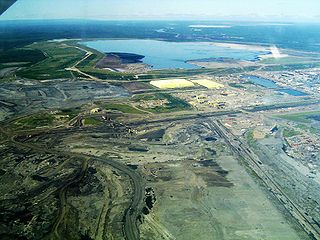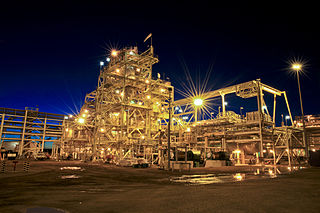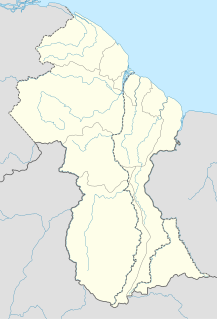It has been suggested that this article be merged into Tailings dam . (Discuss) Proposed since February 2019. |
The following table lists the largest tailings dam failures by volume of substance released. The released substance may be water or tailings, or, as is most often the case, a considerable quantity of both.

A tailings dam is typically an earth-fill embankment dam used to store byproducts of mining operations after separating the ore from the gangue. Tailings can be liquid, solid, or a slurry of fine particles, and are usually highly toxic and potentially radioactive. Solid tailings are often used as part of the structure itself.
| Name | Released volume [103 m3] | Date of failure | Country | Environmental consequences | Reservoir volume [103 m3] | Dam type | Notes |
|---|---|---|---|---|---|---|---|
| Padcal No. 2 | 80,000 [1] 32,000 [2] | 1992 January 2 | Philippines | Damaged "large tracts of prime agricultural land"; mine paid penalties to provincial treasury of Pangasinan. [3] | 80,000 [4] | Copper mine. Dam wall collapsed. [5] | |
| Mariana dam disaster (Bento Rodrigues, Samarco) [6] | 60,000 32,000 [5] | 2015 November 5 | Brazil | Significant contamination of Rio Doce and Atlantic Ocean. | 55,000 [5] | Iron ore tailings [7] Flávio Fonseca de Carmo, Luciana Hiromi et. al say 43x106 m3 of tailings released, which was 80% of the stored volume. [2] | |
| Brumadinho dam disaster | 12,000 | 2019 January 25 | Brazil | Metals in tailings to be incorporated into rivers' soil. | Earth | Iron ore tailings. | |
| Ajka alumina plant accident | 1000 | 2010 October 4 | Hungary | The waste extinguished all life in the Marcal river, alkaline mud reached the Danube | Red mud | ||
| Sipalay | 30,000 [8] [9] | 1982 Nov. 8 [10] | Philippines | "Widespread inundation of agricultural land up to 1.5 m high" | 37,000 [5] | Dam failure, due to slippage of foundation [11] | |
| Mount Polley | 15,000 [12] 23,600 [5] | 2014 August 4 | Canada | 74,000 [13] | 4.5 Mm3 water, 10 Mm3 metals-laden tailings, plus interstitial water in tailings. | ||
| American Cyanamid | 11,400 [14] | 1962 | U.S.A. | Acidic water flowed into a wetland called Hooker's Prairie. It was contained there and limed before discharge into South Prong of Alafia River. | Phosphate, Florida. [5] | ||
| Padcal No. 3 | 5,000-10,000 | 2012 August 3 | Philippines | Balog and Agno Rivers heavily polluted. | 250,000 [15] 102,000 [5] | Copper mine [5] | |
| Pinchi Lake | 6,000-8,000 | 2004 Nov. 30 | Canada | Tlatzen First Nation alleges mercury has destroyed fishery in the lake. | Mercury mine waste containment dam collapses. [16] [5] | ||
| Payne Creek Mine | 6,800 | 1994 Oct 2 | U.S.A. | Water from a clay settling pond. Majority of release contained on adjacent mining area; 500,000 m3 escaped into a creek [11] | |||
| Doñana disaster | 4,500 6,800 [5] | 1998 April 25 | Spain | 15,000 [5] | Acidic tailings containing heavy metals | ||
| Omai mine | 4,200 | 1995 August 19 | Guyana | 5,250 [5] | Gold mine. Tailings release contained cyanide. | ||
| Kingston power plant | 4,100 | 2008 Dec. 22 | U.S.A. | Heavy metals; large fish kill; town inundated; | Fly ash slurry from a coal-fired power plant. | ||
| Balka Cuficheva | 3,500 | 1981 January 20 | Soviet Union | 27,000 [5] | Iron. [11] | ||
| Los Cedros | 1,500-3,000 [17] | 1937 May 27 | Mexico | > 300 human fatalities | 25,000 (estimate) [18] | Silver and gold mine. [17] | |
| Quinette, Maemot | 2,500 [5] | 1985 | Canada | River valley filled with waste for 2.5 km. [5] | Coal mine. | ||
| Rio Pomba Cataguases | 2,000 | 2007 10 January | Brazil | Bauxite (Aluminum) mine [5] | |||
| Tyrone, New Mexico | 2,000 | 1980 Oct. 13 | U.S.A. | Tailings flow 8 km downstream and inundate farmland. | Copper mine. [11] | ||
| Hopewell Mine | 1,900 | 1994 Nov 19 | U.S.A. | Spill into wetlands and Alafia River | Water from a clay settling pond [11] | ||
| Merriespruit | 690 [19] | 1994 February 22 | South Africa | Slurry travelled 2 km, covering about 1⁄2 km2. 17 fatalities. | 7,040 [5] | Gold mine. [20] | |
| 2008 Shanxi mudslide | 2008 | China |












